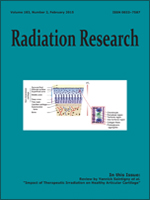The purpose of this study was to determine the relative biological effectiveness (RBE) along the axis of two range-modulated proton beams (160 and 230 MeV). Both the depth and the dose dependence of RBE were investigated. Chinese hamster V79-WNRE cells, suspended in medium containing gelatin and cooled to 2°C, were used to obtain complete survival curves at multiple positions throughout the entrance and 10 cm spread-out Bragg peak (SOBP). Simultaneous measurements of the survival response to 60Co gamma rays served as the reference data for the proton RBE determinations. For both beams the RBE increased significantly with depth in the 10 cm SOBP, particularly in the distal half of the SOBP, then rose even more sharply at the distal edge, the most distal position measured. At a 4 Gy dose of gamma radiation (S = 0.34) the average RBE values for the entrance, proximal half, distal half and distal edge were 1.07 ± 0.01, 1.10 ± 0.01, 1.17 ± 0.01 and 1.21 ± 0.01, respectively, and essentially the same for both beams. At a 2 Gy dose of gamma radiation (S = 0.71) the average RBE values rose to 1.13 ± 0.03, 1.15 ± 0.02, 1.26 ± 0.02 and 1.30 ± 0.02, respectively, for the same four regions of the SOBP. The difference between the 4 Gy and 2 Gy RBE values reflects the dose dependence of RBE as measured in these V79-WNRE cells, which have a low α/β value, as do other widely used cell lines that also show dose-dependent RBE values. Late-responding tissues are also characterized by low α/β values, so it is possible that these cell lines may be predictive for the response of such tissues (e.g., spinal cord, optic nerve, kidney, liver, lung). However, in the very small number of studies of late-responding tissues performed to date there appears to be no evidence of an increased RBE for protons at low doses. Similarly, RBE measurements using early responding in vivo systems (mostly mouse jejunum, an early-responding tissue which has a large α/β ∼10 Gy) have generally shown little or no detectable dose dependence. It is useful to compare the RBE values reported here to the commonly used generic clinical RBE of 1.1, which assumes no dependence on depth or on dose. Our proximal RBEs obviously avoid the depth-related increase in RBE and for doses of 4 Gy or more, the low-dose increase in RBE is also minimized, as shown in this article. Thus the proximal RBE at a 4 Gy dose of 1.10 ± 0.01, quoted above, represents an interesting point of congruence with the clinical RBE for conditions where it could reasonably be expected in the measurements reported here. The depth dependence of RBE reported here is consistent with the majority of measurements, both in vitro and in vivo, by other investigators. The dose dependence of RBE, on the other hand, is tissue specific but has not yet been demonstrated for protons by RBE values in late-responding normal tissue systems. This indicates a need for additional RBE determination as function of dose, especially in late-responding tissues.
How to translate text using browser tools
14 January 2015
Radiobiological Intercomparison of the 160 MeV and 230 MeV Proton Therapy Beams at the Harvard Cyclotron Laboratory and at Massachusetts General Hospital
Bradly G. Wouters,
Lloyd D. Skarsgard,
Leo E. Gerweck,
Alejandro Carabe-Fernandez,
Michelle Wong,
Ralph E. Durand,
Deanna Nielson,
Marc R. Bussiere,
Miles Wagner,
Peter Biggs,
Harald Paganetti,
Herman D. Suit
ACCESS THE FULL ARTICLE

Radiation Research
Vol. 183 • No. 2
February 2015
Vol. 183 • No. 2
February 2015




